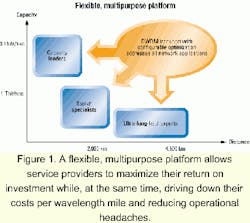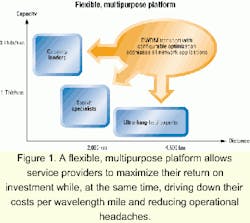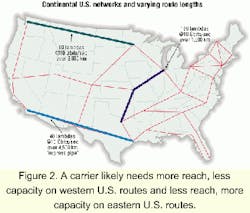Flexible, multipurpose platforms maximize return on investment
New single platforms are configured economically on a route-by-route basis for maximum performance and reduced costs.
STEPHAN RETTENBERGER and WILL RUSS,
Optisphere Networks
As end users take advantage of more and more Internet-based applications, they are unleashing a torrent of data traffic across the network. To keep pace with the resulting demand for additional bandwidth, service providers are looking for every possible means to increase the capacity of their transport networks. Most are deploying high-capacity DWDM systems and the requisite SONET multiplexers. Although these technologies deliver much-needed additional capacity, they represent enormous investments-not just in terms of equipment, but also in associated real estate, power, and ongoing operational expenses.
Unfortunately, many of these systems turn out to be only partial solutions. Typically, most DWDM systems focus on only one aspect of the overall transport challenge and are not sufficiently flexible to be optimized on a route-by-route basis. Short, high-capacity systems provide necessary wavelength counts, but they cannot scale to satisfy ultra-long-reach route requirements. Similarly, ultra-long-reach systems cover adequate distances but all too often lack a clear evolutionary path for the cost-effective addition of more wavelengths. Finally, systems that focus on dynamic bandwidth provisioning feature built-in switching and grooming functionalities, but they cannot deliver reliable, high-capacity, ultra-long-reach transport.
Therefore, to achieve the necessary network capacity-where and when they need it-carriers are forced to invest in multiple, single-purpose DWDM platforms. This piecemeal approach increases their up-front capital requirements, ties up money that could be put to more effective use elsewhere, and boosts the financial and labor costs associated with ongoing operational and maintenance chores.To help carriers avoid this expensive approach, some vendors now offer a multipurpose optical transport solution: a single platform that can be configured economically on a route-by-route basis for maximum performance, according to specific distance, wavelength count, bit rate per wavelength, and service requirements (see Figure 1). This flexible, multipurpose platform allows service providers to maximize their return on investment, while at the same time driving down their costs per wavelength mile and reducing operational headaches.
Given the surging use of the Internet and the appetite on the part of both business organizations and individual consumers for more bandwidth, service providers need to add more and more capacity to their networks. Yet often, their embedded DWDM systems lack both the reach and density to allow them to accommodate growing traffic volumes quickly and cost-effectively.
Without sufficient reach in a DWDM system, today's SONET architecture dictates that a carrier needing to turn up another channel must establish numerous regeneration sites in the network, roughly at 500-km intervals. That is a cumbersome, expensive, and time-consuming process. By contrast, a DWDM system with a longer reach enables the carrier to deploy signal-regeneration equipment only at sites where growing traffic volumes require it.
Similarly, today's DWDM systems typically support 32 wavelengths. As carriers exhaust their 32-wavelength platforms, they are forced to deploy a second platform to increase overall network capacity. Added to the equipment cost of the second platform are the expense and time required to move traffic onto that second system. Obviously, a preferable solution would be a single DWDM platform that can scale to a higher wavelength count and, relative to multiple systems, is simpler and more economical to operate.
Generally, a "short, fat pipe" describes a DWDM system designed to reach 400-500 km and provide a maximum capacity of about 1.6 Tbits. The specific system architecture and the laws of physics dictate the distance to which the system can scale. Within most system designs, it is impossible to grow to greater distance, even if the carrier accepts some tradeoffs in terms of channel count. Typically, spans are limited by optical signal-to-noise ratio, ripple in power levels or nonlinearities such as four-wave mixing.
Therefore, a carrier deploying a single-configuration (short, high-capacity) DWDM system cannot optimize it to cover greater distances on specific routes. Specifically, the carrier cannot take full advantage of Raman amplification, which can be an alternative or supplement to the well-known concept of the erbium-doped fiber amplifier (EDFA). An EDFA typically is a discrete fiber-optic device with a dedicated doped fiber that functions as the amplifying medium outside of the optical-fiber span. Raman amplification involves the splicing of a laser pump directly into the fiber span, effectively making that span the actual gain medium.
As the signal travels down the fiber, it encounters "light" from the Raman pump, which operates on a shorter wavelength. By transferring some of its energy to the longer, traffic-bearing wavelengths, that light amplifies the signal. Because the fiber itself is the gain medium, the signal doesn't have to go through extra fiber-as it would in an EDFA-and therefore sees a shorter span. Combined with traditional EDFA technology, Raman amplification delivers powerful system performance in terms of both capacity and reach.
Effective Raman amplification is not possible, for example, in a bidirectional interleaved DWDM system. In a configurable, multipurpose DWDM platform, however, effective Raman amplification helps to maximize the return on investment by enabling the carrier to optimize the system for better performance and longer reach.
Ultra-long-reach DWDM systems often use only the C-band amplifier, which typically supports anywhere from 40 to 80 wavelengths and provides capacity of 1 to 1.6 Tbits. With such a channel count, the system is capable of covering a distance of 2,000-3,000 km, possibly up to 4,000 km. Obviously, the fewer wavelengths involved, the greater the achievable distance.
While such a single-purpose platform works well in many applications, its limitations are readily apparent on routes where the carrier needs a relatively shorter reach, such as only 500 km, but requires more than 1 Tbit of capacity. To handle traffic volumes on those routes, the carrier is forced to make the expensive choice of deploying a parallel system, or a short, fat pipe.On routes in western parts of the United States, a carrier likely requires more reach but less capacity (see Figure 2). On East Coast routes, however, that same carrier probably would need more capacity but less reach. Consequently, because single-purpose platforms cannot be configured to address a range of requirements, the carrier would have to select vendor A's long, thin pipe for the western routes and vendor B's short, fat pipe for the eastern routes. That translates into not only additional equipment costs, but also the need to invest in more spares, training, engineering, and vendor management.
By contrast, a multipurpose DWDM platform allows carriers to configure the system as a short, fat pipe or a long, thin pipe, depending on business requirements and geography. Such a configurable platform provides very high capacity-up to 160 wavelengths today-over a distance of up to 500 km without Raman amplification or 1,600 km with Raman amplifiers. Also, by using fewer wavelengths, it can extend its reach up to 2,800 km for 80 wavelengths and 4,500 km for 40 wavelengths. Because the carrier can tailor it to virtually every network application, a configurable, multipurpose DWDM platform offers significant savings in terms of financial and operational resources.
There is much talk in the marketplace today about the potential of optical-crossconnect systems functioning in a meshed network to help resolve the backbone capacity issue. Various vendors are pursuing different technologies, some of them with promising success. However, such intelligent wavelength nodes comprise just one, very limited piece of the transport puzzle. Unless these nodes are connected via powerful and versatile transport pipes, they address only one part of the problem.
Although some of them may include DWDM platforms, they still are not advanced, comprehensive transport solutions. With their built-in switching and grooming functionalities, they focus on traffic requirements only at individual nodes. They do not have the reach nor the channel count to satisfy carriers' overall network capacity requirements.
Squeezed on one side by customer demands and on the other side by the need to drive down costs, competitive carriers would like to replace their multiple, single-purpose DWDM platforms with a single platform-specifically designed to accommodate all aspects of high-capacity transport. They are seeking a configurable optical transport solution that can be optimized according to those varying requirements of their network routes mentioned earlier: distance, wavelength count, bit rate per wavelength, and service offering.
In response to carrier requirements, some vendors offer such optical-networking platforms. Combining high performance, an open DWDM platform, and a modular design, these multipurpose systems enable carriers to handle current and future transport requirements. Features of these configurable systems include:
- Modular, in-service upgrades to EDFAs that minimize amplifier cost for a given wavelength.
- Optional EDFA gain profiles that optimize the optical signal-to-noise ratio for shorter spans, thus reducing costs and extending optical reach.
- Optional Raman amplifiers for use on long-multiplexed sections, thus extending the optical reach while avoiding expensive regeneration.
- Modular growth of the optical multiplexer and demultiplexer filters to allow for the configuration of long, thin pipes without stranding equipment investments.
- Stringent filter performance, coupled with an infrastructure that supports high channel counts on the order of 3.2 Tbits per fiber.
- Optional mid-span power equalization of individual wavelengths to minimize the cumulative gain tilt in an amplifier chain, thus making it possible to configure long, thin pipes and even "longer" fat pipes without removing wavelengths.
- Advanced dispersion management, featuring separate compensators for the C- and L-bands for increased accuracy. Slope-matched compensators further reduce residual dispersion to extend the optical reach.
- Open platform. Because they are compatible with 10-Gbit/sec systems and different bit-rate and modulation formats, these systems eliminate the need for transponders. Optional transponders are available to allow any wavelength "open" access to the transport network.
- Integrated optical-layer regeneration. If the maximum regenerator-free distance has to be exceeded, these systems provide 10-Gbit/sec regeneration functionality in the optical layer at a fraction of the cost and size of traditional SONET/SDH regenerators. As a result, they significantly reduce overall costs and space requirements.
- Compact design. Because of their modular design, these systems enable carriers to use expensive floor space with maximum efficiency.
Perhaps one of the more important characteristics of a configurable optical transport platform is modular design. By allowing carriers to add more channels of capacity according to actual traffic demands, these modular systems make it possible to build transport networks on a pay-as-you-grow basis.
In fact, some new platforms extend the concept of modularity even further to include common equipment such as optical line amplifiers and optical regenerators. For example, the optical amplifier design in some systems consists of various building blocks, beginning with a basic C- or L-band version and then upgraded versions of both via external pumps as well as optional Raman amplification.
Some systems also feature a modular approach to multiplexers. Carriers have the flexibility to deploy the optical filters in the DWDM terminals in incremental groups of 20 wavelengths versus getting 160 wavelengths all at once and having to pay for and deploy all that equipment. More precisely, carriers can invest only in the capacity they need, when they need it.
Yet another critical aspect of these configurable systems is their ability to balance equipment modularity with component integration. For example, if a carrier needs to increase transport capacity by 20 wavelengths in the next year, that carrier has two choices: buy a 32-wavelength system or 160-wavelength system. The smaller platform obviously would be a smaller capital investment than the larger system. On the other hand, the 160-wavelength system, albeit sporting a higher initial cost, would satisfy the need for additional capacity not just next year but well into the future. Which is the better choice?
Carriers want a solution that not only minimizes the initial cost but also controls the incremental-growth costs. Some new DWDM systems provide just such a solution, primarily by balancing equipment modularity with component integration. By allowing the carrier to integrate many components on one equipment module, the 160-wavelength system saves costs and, through greater equipment density, saves space. In other words, traditional smaller systems may offer a little too much modularity and not enough component integration. As a result, they could turn out to be more expensive in the long run in terms of money, space, and power.
By deploying a single, multipurpose, configurable optical transport system, carriers can invest in additional backbone capacity on the basis of their actual business requirements rather than according to the design of a given DWDM system. A flexible, modular transport platform that can be configured as a short, fat pipe on one route and a long, thin pipe on another route enables carriers to achieve the maximum return on their equipment investments and reduce the cost per wavelength mile throughout the network.
A configurable optical transport solution also reduces the need for, and cost of, spare modules, technical training, and vendor management re sources. Further, it minimizes the time and expense associated with the inevitable customization of equipment provisioning. In short, an intelligent DWDM system design that takes into account the myriad reach and capacity requirements of current and future networks is the ideal choice for today's competitive carriers.
Stephan Rettenberger is director of product-line management and Will Russ is market development manager at Optisphere Networks Inc. (Reston, VA), a wholly owned subsidiary of Siemens Information and Communications Networks Inc.


